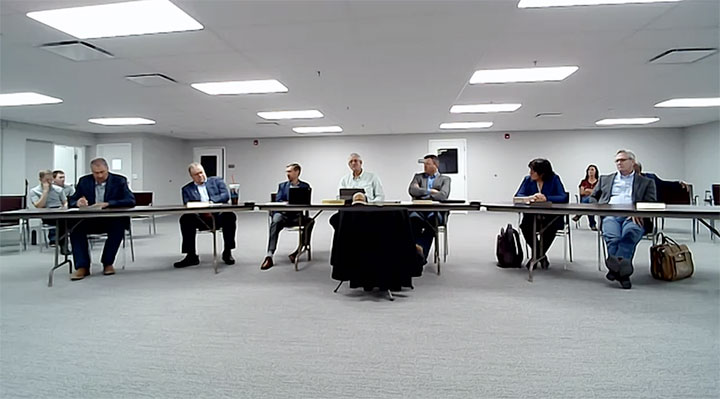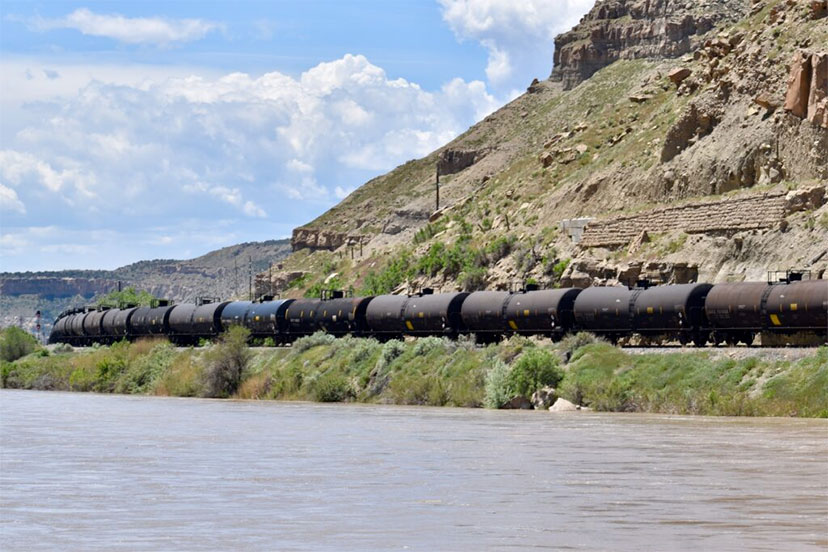PHOTO: A train of tanker cars travels the tracks along the Colorado River near Cameo on May 16, 2023. (Chase Woodruff/Colorado Newsline)
This article series by Chase Woodruff appeared on Colorado Newsline beginning on June 26, 2023.. We are sharing it in multiple parts.
As they head east out of the bottomlands of the Grand Valley, trains on the Union Pacific’s Central Corridor continue to follow the Colorado River in reverse, climbing gradually into Garfield County, where the rocky cliffs and sagebrush-spotted scrubland of the high desert begin to give way to the gentler slopes and lush alpine forests of the Rocky Mountains.
The railroad and Interstate 70 run in parallel through this narrow stretch of the Colorado River Valley for 60 miles, rarely separated by more than 100 yards as they pass industrial lots lined with frac tanks and truck-mounted drill rigs, and narrow strips of Bureau of Land Management acreage where sheep graze beside natural gas compressors and flare stacks.
The communities that the Central Corridor passes through between the Grand Valley and Glenwood Canyon have long been shaped by the boom-and-bust cycles of fossil fuel extraction, their economic fortunes rising and falling along with the viability of the energy sources buried underneath them — first coal, then oil, and now natural gas, extracted from a subterranean formation known as the Piceance Basin.
“We’re an oil and gas county,” Garfield County Commissioner Tom Jankovsky said in an interview. “We have some of the largest natural gas reserves in the United States, and we do a lot of work to protect those revenues.”
U.S. Rep. Lauren Boebert, the far-right congresswoman who has made “drill, baby, drill” a signature agenda item alongside her denial of the 2020 election, calls Garfield County home, having run her gun-themed Shooters Grill restaurant in Rifle for almost a decade before bursting onto the political scene with a victory in the 3rd District Republican primary in 2020.
The Piceance gas boom, which peaked a decade ago, swelled county property-tax revenues and provided many families like the Boeberts with high-paying jobs. But a confluence of factors, topped by a global decline in natural gas prices, has gradually soured the basin’s outlook. Corporate oil giants like ExxonMobil and Occidental have largely divested from their holdings here, and Garfield County’s total gas production last year was only slightly more than half of 2013 levels.
It’s a lesson that’s been learned over the decades in the Piceance Basin: to sit atop vast reserves of valuable natural resources often isn’t enough on its own to bring a town or a region prosperity, especially in the wide-open spaces of the West. Whether it’s a lack of infrastructure, technological limitations, the pressures of global commodity markets or simply bad geological luck, obstacles to resource extraction have a way of cropping up.
And it’s a lesson that drillers and county governments in eastern Utah’s Uinta Basin, a hundred miles west, have learned, too.
Although the two basins form a nearly continuous 200-mile-wide belt of underground hydrocarbon reservoirs straddling the Colorado-Utah border, producing oil and gas from many of the same layers of prehistoric rock, the Piceance and the Uinta have little to do with each other on the surface.
Travel between them is possible only by circuitous highway routes that skirt north or south around the rugged Roan Plateau.
Soon, though, that could change in a big way. The 88-mile Uinta Basin Railway, proposed by a partnership between industry and Utah county governments, would establish a direct rail connection between the basin and Garfield County for the first time in nearly a century.
The result would be one of the largest sustained efforts to transport crude oil by rail ever undertaken in the U.S., sending hundreds of fully loaded tanker cars daily along the banks of the Colorado River through Garfield County — and many residents here aren’t happy about it.
“Nobody wants it,” Caitlin Carey, a Town Council member in New Castle, said in an interview. “It’s not a sound decision environmentally, it’s not a sound decision as far as safety is concerned in our small towns, and it’s not bringing any revenue to the area. So economically, environmentally and safety-wise, it doesn’t make any sense for it to come through this area.”
Mile 79: Parachute
Seven miles past the Garfield County line, eastbound trains on the Central Corridor route roll through Parachute, population 1,390. It’s the county’s smallest incorporated town, paling in comparison even to Battlement Mesa, an unincorporated retirement community on the other side of the Colorado River.
Together, they make a pair of quiet rural villages that have spread out over the ridges of the river valley — but within the lifetimes of many of their residents, officials at the highest levels of corporate America and Colorado state government planned for this to be the center of a new metropolis.
The same geological formations that produce natural gas in Garfield County and waxy crude oil in the Uinta Basin hold a much larger deposit of another hydrocarbon resource: oil shale. When subjected to subterranean heat and pressure over millions of years, the components of oil shale break down to form oil and gas, but it can also be mined and, with some difficulty, processed to produce synthetic fuels. Parts of Colorado, Utah and Wyoming sit atop by far the largest oil shale deposit in the world; the amount of synthetic oil that could be produced from this deposit alone, according to some estimates, is more than double the entirety of the world’s conventional crude oil resources.
Parachute was the epicenter of the most ambitious attempt to unlock the potential of “the rock that burns,” launched by Exxon in 1980, after a decade of sky-high oil prices had spurred a nationwide search for alternative energy sources.
The multibillion-dollar Colony Project envisioned massive oil shale strip mines across Garfield and Rio Blanco counties and synthetic fuel plants that would produce a staggering 15 million barrels per day. Exxon began developing Battlement Mesa to house the project’s workforce as job-seekers flocked to the Western Slope from all around the country. Local governments prepared for more than 200,000 new residents to move into the narrow valley between Parachute and New Castle by 2010; Exxon’s own projections suggested it would be as many as 1.5 million people.
It was the most feverish energy boom in Colorado history, and it wasn’t long before things went bust. Within two years, oil prices began to fall again, and interest in the development of costly new synthetic fuels evaporated. Exxon abruptly pulled the plug on the Colony Project on May 2, 1982, known locally as “Black Sunday.” Thousands lost their jobs overnight, property values plummeted and hundreds of businesses went under in a crash that left its mark on Garfield County for decades.
“It’s a blow for the state and also a blow for the country, which needs alternate energy resources,” then-Gov. Dick Lamm — a cantankerous environmentalist who had nonetheless welcomed Exxon’s investment in Colorado — told The Denver Post shortly after Black Sunday. “This is part of the boom-and-bust cycle the West has been experiencing throughout its history.”
Utah has seen its own share of abortive attempts to mine oil shale, but lately, drilling interests in the Uinta Basin have set their sights on an ambitious effort to overcome a longstanding obstacle to development of the region’s conventional crude oil resources.
Although vast reserves were discovered there in 1948, the high degree of paraffin, or wax, in the Uinta Basin’s crude oil has kept a hard ceiling on its output. Though not as complicated as squeezing synthetic fuels out of oil shale, processing waxy crude comes with a unique set of challenges; because it congeals into a solid at room temperature, conventional pipelines aren’t an option, and it must be heated to be loaded in and out of tanker trucks and rail cars, or blended into thinner crudes in small enough proportions that it won’t cause a blockage.
The Seven County Infrastructure Coalition, a public body made up of the Uinta Basin’s local governments, has worked with industry groups for years to study potential solutions, including a costly insulated pipeline that would be able to transport the waxy crude at high temperatures… or a “cracking” process that would partially refine and liquify it within the Basin.

“There’s only those two-lane highways. How do you get bulk commodities out? You can’t do it very effectively, you can’t do it very safely,” Keith Heaton, the SCIC’s executive director, said at the group’s monthly meeting in June. “Not to criticize the way it’s been done, but you need transportation.”
In 2019, the SCIC settled on an answer: a new railway that would connect the basin to the national rail network, allowing its waxy crude to be shipped to refineries out of state. The SCIC’s effort, in partnership with private equity firm Drexel Hamilton and the short-line railroad company Rio Grande Pacific, revived a state-led railway plan that was dropped in 2014 over concerns about high costs.
The railway’s proponents point to extensive research showing that railroads are a safer mode of transport for hazardous materials than trucks. Tanker trucks hauling waxy crude out of the Uinta Basin have been involved in repeated accidents and spills since production began to rise in the region a decade ago.
During a two-year-long environmental review process, the Uinta Basin Railway’s backers told federal regulators that its construction could nearly quintuple the Basin’s daily oil production to over 440,000 barrels per day — an output that would put the Uinta Basin on par with northeast Colorado’s Denver-Julesburg Basin, currently the largest oilfield in the Mountain West.
They estimated that 90% of the additional output — potentially over 400 tanker cars full of heated waxy crude per day — would be shipped by train on the Union Pacific’s eastbound route through western and central Colorado, before taking one of several routes out of the Denver metro area to refineries in Texas, Oklahoma or Louisiana.
In December 2021, the federal Surface Transportation Board voted 4-1 to approve the new railway. Conservation groups and Colorado’s Eagle County have sued the STB over the decision, calling the board’s environmental review “fatally flawed,” and state leaders have asked at least four different federal agencies to bring a halt the project.
But so far, President Joe Biden’s administration has shown no signs of hitting the brakes.
The railway partnership’s announcement earlier this year that it would seek $2 billion in tax-exempt Private Activity Bonds, which must be approved by the U.S. Department of Transportation, opened a new front in Colorado leaders’ battle to stop the project. The Center for Biological Diversity, one of the groups suing to overturn the STB’s approval, estimates that the bonds’ lower financing costs would amount to an $80 million annual federal subsidy to the interests behind the railway.

